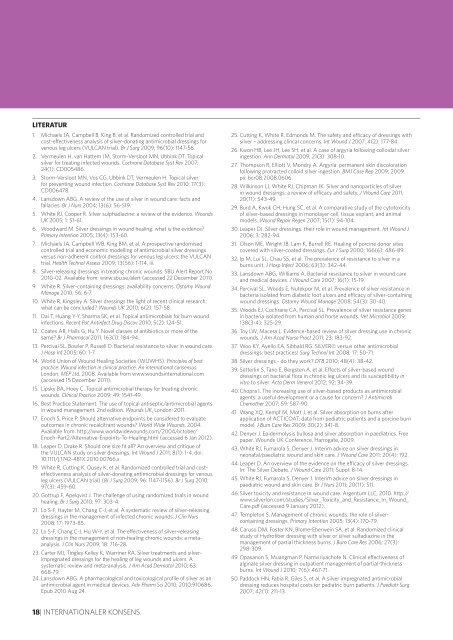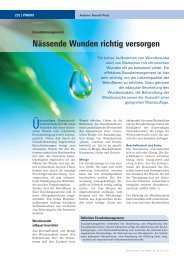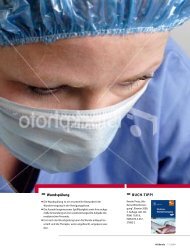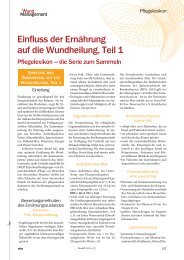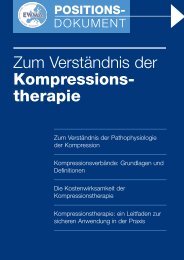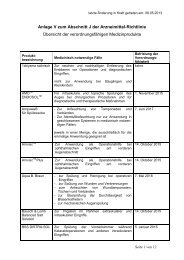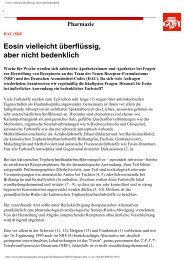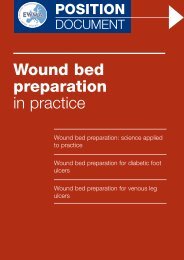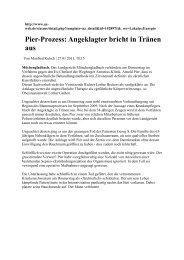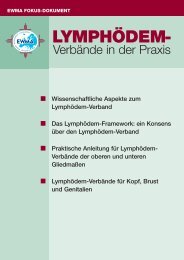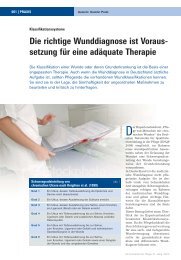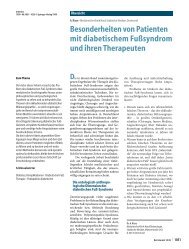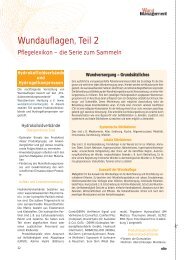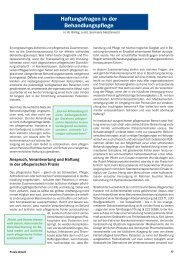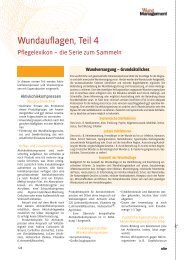adäquate anwendung von silberverbänden bei wunden - Wounds ...
adäquate anwendung von silberverbänden bei wunden - Wounds ...
adäquate anwendung von silberverbänden bei wunden - Wounds ...
Sie wollen auch ein ePaper? Erhöhen Sie die Reichweite Ihrer Titel.
YUMPU macht aus Druck-PDFs automatisch weboptimierte ePaper, die Google liebt.
LITERATUR<br />
1. Michaels JA, Campbell B, King B, et al. Randomized controlled trial and<br />
cost-effectiveness analysis of silver-donating antimicrobial dressings for<br />
venous leg ulcers (VULCAN trial). Br J Surg 2009; 96(10): 1147-56.<br />
2. Vermeulen H, van Hattem JM, Storm-Versloot MN, Ubbink DT. Topical<br />
silver for treating infected wounds. Cochrane Database Syst Rev 2007;<br />
24(1): CD005486.<br />
3. Storm-Versloot MN, Vos CG, Ubbink DT, Vermeulen H. Topical silver<br />
for preventing wound infection. Cochrane Database Syst Rev 2010; 17(3):<br />
CD006478.<br />
4. Lansdown ABG. A review of the use of silver in wound care: facts and<br />
fallacies. Br J Nurs 2004; 13(6): S6-S19.<br />
5. White RJ, Cooper R. Silver sulphadiazine: a review of the evidence. <strong>Wounds</strong><br />
UK 2005; 1: 51-61.<br />
6. Woodward M. Silver dressings in wound healing: what is the evidence<br />
Primary Intention 2005; 13(4): 153-60.<br />
7. Michaels JA, Campbell WB, King BM, et al. A prospective randomised<br />
controlled trial and economic modelling of antimicrobial silver dressings<br />
versus non-adherent control dressings for venous leg ulcers: the VULCAN<br />
trial. Health Technol Assess 2009; 13(56): 1-114, iii.<br />
8. Silver-releasing dressings in treating chronic wounds. SBU Alert Report No<br />
2010-02. Available from: www.sbu.se/alert (accessed 22 December 2011).<br />
9. White R. Silver-containing dressings: availability concerns. Ostomy Wound<br />
Manage 2010; 56: 6-7.<br />
10. White R, Kingsley A. Silver dressings the light of recent clinical research:<br />
what can be concluded <strong>Wounds</strong> UK 2010; 6(2): 157-58.<br />
11. Dai T, Huang Y-Y, Sharma SK, et al. Topical antimicrobials for burn wound<br />
infections. Recent Pat Antinfect Drug Discov 2010; 5(2): 124-51.<br />
12. Coates AR, Halls G, Hu Y. Novel classes of antibiotics or more of the<br />
same Br J Pharmacol 2011; 163(1): 184-94.<br />
13. Percival SL, Bowler P, Russell D. Bacterial resistance to silver in wound care.<br />
J Hosp Inf 2005; 60: 1-7.<br />
14. World Union of Wound Healing Societies (WUWHS). Principles of best<br />
practice: Wound infection in clinical practice. An international consensus.<br />
London: MEP Ltd, 2008. Available from www.woundsinternational.com<br />
(accessed 15 December 2011).<br />
15. Lipsky BA, Hoey C. Topical antimicrobial therapy for treating chronic<br />
wounds. Clinical Practice 2009; 49: 1541-49.<br />
16. Best Practice Statement: The use of topical antiseptic/antimicrobial agents<br />
in wound management. 2nd edition. <strong>Wounds</strong> UK, London: 2011.<br />
17. Enoch S, Price P. Should alternative endpoints be considered to evaluate<br />
outcomes in chronic recalcitrant wounds World Wide <strong>Wounds</strong>, 2004.<br />
Available from: http://www.worldwidewounds.com/2004/october/<br />
Enoch-Part2/Alternative-Enpoints-To-Healing.html (accessed 6 Jan 2012).<br />
18. Leaper D, Drake R. Should one size fit all An overview and critique of<br />
the VULCAN study on silver dressings. Int Wound J 2011; 8(1): 1-4. doi:<br />
10.1111/j.1742-481X.2010.00766.x.<br />
19. White R, Cutting K, Ousey K, et al. Randomized controlled trial and costeffectiveness<br />
analysis of silver-donating antimicrobial dressings for venous<br />
leg ulcers (VULCAN trial) (Br J Surg 2009; 96: 1147-1156). Br J Surg 2010;<br />
97(3): 459-60.<br />
20. Gottrup F, Apelqvist J. The challenge of using randomized trials in wound<br />
healing. Br J Surg 2010; 97: 303-4.<br />
21. Lo S-F, Hayter M, Chang C-J, et al. A systematic review of silver-releasing<br />
dressings in the management of infected chronic wounds. J Clin Nurs<br />
2008; 17; 1973-85.<br />
22. Lo S-F, Chang C-J, Hu W-Y, et al. The effectiveness of silver-releasing<br />
dressings in the management of non-healing chronic wounds: a metaanalysis.<br />
J Clin Nurs 2009; 18: 716-28.<br />
23. Carter MJ, Tingley Kelley K, Warriner RA. Silver treatments and silverimpregnated<br />
dressings for the healing of leg wounds and ulcers: A<br />
systematic review and meta-analysis. J Am Acad Dermatol 2010; 63:<br />
668-79.<br />
24. Lansdown ABG. A pharmacological and toxicological profile of silver as an<br />
antimicrobial agent in medical devices. Adv Pharm Sci 2010; 2010:910686.<br />
Epub 2010 Aug 24.<br />
25. Cutting K, White R, Edmonds M. The safety and efficacy of dressings with<br />
silver – addressing clincal concerns. Int Wound J 2007; 4(2): 177-84.<br />
26. Kwon HB, Lee JH, Lee SH, et al. A case of argyria following colloidal silver<br />
ingestion. Ann Dermatol 2009; 21(3): 308-10.<br />
27. Thompson R, Elliott V, Mondry A. Argyria: permanent skin discoloration<br />
following protracted colloid silver ingestion. BMJ Case Rep 2009; 2009.<br />
pii: bcr08.2008.0606.<br />
28. Wilkinson LJ, White RJ, Chipman JK. Silver and nanoparticles of silver<br />
in wound dressings: a review of efficacy and safety. J Wound Care 2011;<br />
20(11): 543-49.<br />
29. Burd A, Kwok CH, Hung SC, et al. A comparative study of the cytotoxicity<br />
of silver-based dressings in monolayer cell, tissue explant, and animal<br />
models. Wound Repair Regen 2007; 15(1): 94-104.<br />
30. Leaper DJ. Silver dressings: their role in wound management. Int Wound J<br />
2006; 3: 282-94.<br />
31. Olson ME, Wright JB, Lam K, Burrell RE. Healing of porcine donor sites<br />
covered with silver-coated dressings. Eur J Surg 2000; 166(6): 486-89.<br />
32. Ip M, Lui SL, Chau SS, et al. The prevalence of resistance to silver in a<br />
burns unit. J Hosp Infect 2006; 63(3): 342-44.<br />
33. Lansdown ABG, Williams A. Bacterial resistance to silver in wound care<br />
and medical devices. J Wound Care 2007; 16(1): 15-19.<br />
34. Percival SL, Woods E, Nutekpor M, et al. Prevalence of silver resistance in<br />
bacteria isolated from diabetic foot ulcers and efficacy of silver-containing<br />
wound dressings. Ostomy Wound Manage 2008; 54(3): 30-40.<br />
35. Woods EJ, Cochrane CA, Percival SL. Prevalence of silver resistance genes<br />
in bacteria isolated from human and horse wounds. Vet Microbiol 2009;<br />
138(3-4): 325-29.<br />
36. Toy LW, Macera L. Evidence-based review of silver dressing use in chronic<br />
wounds. J Am Acad Nurse Pract 2011; 23: 183-92.<br />
37. Woo KY, Ayello EA, Sibbald RG. SILVER© versus other antimicrobial<br />
dressings: best practices! Surg Technol Int 2008; 17: 50-71.<br />
38. Silver dressings - do they work DTB 2010; 48(4): 38-42.<br />
39. Sütterlin S, Tano E, Bergsten A, et al. Effects of silver-based wound<br />
dressings on bacterial flora in chronic leg ulcers and its susceptibility in<br />
vitro to silver. Acta Derm Venerol 2012; 92; 34-39.<br />
40. Chopra I. The increasing use of silver-based products as antimicrobial<br />
agents: a useful development or a cause for concern J Antimicrob<br />
Chemother 2007; 59: 587-90.<br />
41. Wang XQ, Kempf M, Mott J, et al. Silver absorption on burns after<br />
application of ACTICOAT: data from pediatric patients and a porcine burn<br />
model. J Burn Care Res 2009; 30(2): 341-8.<br />
42. Denyer J. Epidermolysis bullosa and silver absorption in paediatrics. Free<br />
paper. <strong>Wounds</strong> UK Conference, Harrogate, 2009.<br />
43. White RJ, Fumarola S, Denyer J. Interim advice on silver dressings in<br />
neonatal/paediatric wound and skin care. J Wound Care 2011; 20(4): 192.<br />
44. Leaper D. An overview of the evidence on the efficacy of silver dressings.<br />
In: The Silver Debate. J Wound Care 2011; Suppl: 8-14.<br />
45. White RJ, Fumarola S, Denyer J. Interim advice on silver dressings in<br />
paediatric wound and skin care. Br J Nurs 2011; 20(11): S11.<br />
46. Silver toxicity and resistance in wound care. Argentum LLC, 2010. http://<br />
www.silverlon.com/studies/Silver_Toxicity_and_Resistance_In_Wound_<br />
Care.pdf (accessed 9 January 2012).<br />
47. Templeton S. Management of chronic wounds: the role of silvercontaining<br />
dressings. Primary Intention 2005; 13(4): 170-79.<br />
48. Caruso DM, Foster KN, Blome-Eberwein SA, et al. Randomized clinical<br />
study of Hydrofiber dressing with silver or silver sulfadiazine in the<br />
management of partial thickness burns. J Burn Care Res 2006; 27(3):<br />
298-309.<br />
49. Opasanon S, Muangman P, Namviriyachote N. Clinical effectiveness of<br />
alginate silver dressing in outpatient management of partial-thickness<br />
burns. Int Wound J 2010; 7(6): 467-71.<br />
50. Paddock HN, Fabia R, Giles S, et al. A silver impregnated antimicrobial<br />
dressing reduces hospital costs for pediatric burn patients. J Paediatr Surg<br />
2007; 42(1): 211-13.<br />
18| INTERNATIONALER KONSENS


